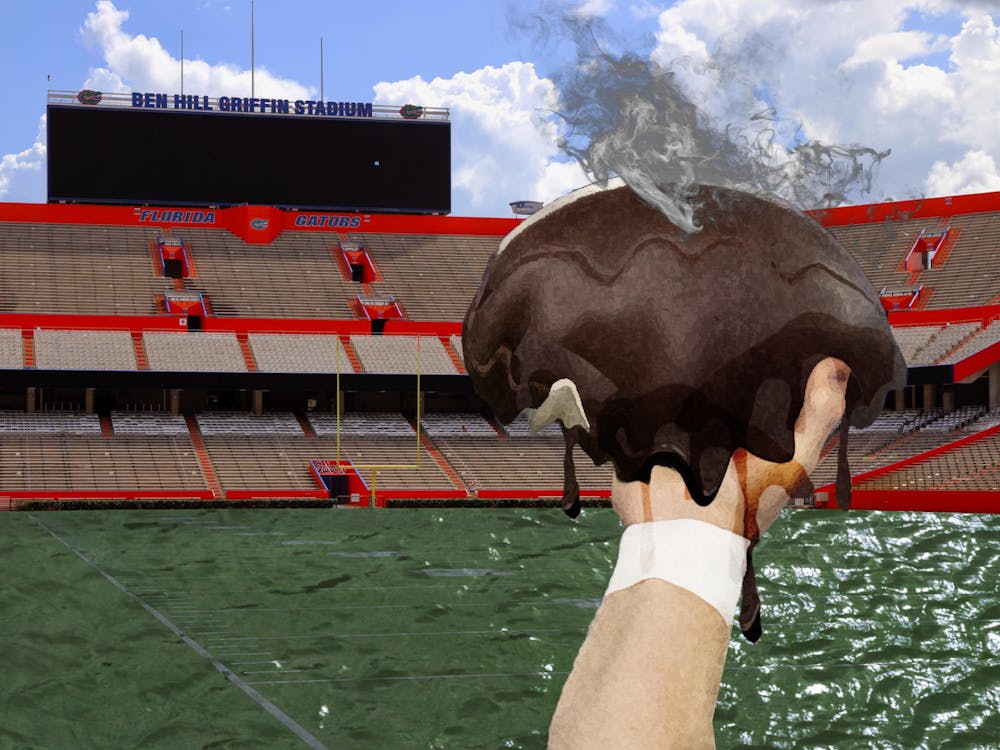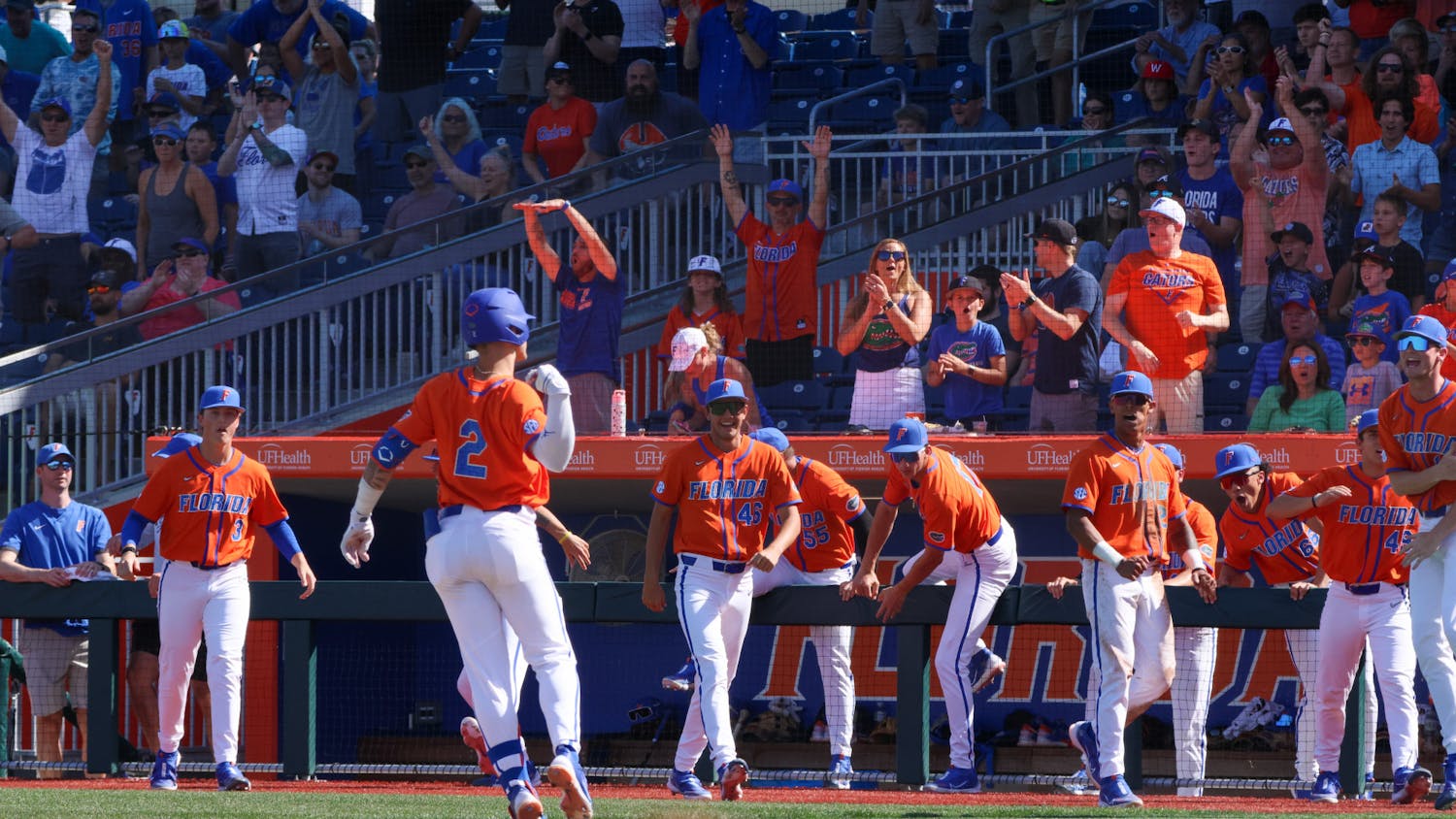Ben Hill Griffin Stadium has served as a formidable fortress for the Florida Gators football team over the years. The Swamp’s humid conditions have given UF an edge, as student-athletes from other teams aren’t as acclimated to the year-round heat.
But rising temperatures could become something much bigger than a home-field advantage.
Average Alachua County temperatures between 1991 to 2020 are higher than those in the 1981 to 2010 period, according to the National Oceanic and Atmospheric Administration.
Numbers have increased by 4.7 degrees Fahrenheit — meaning now more than ever, heat is affecting outdoor sports as conversations emerge about how to best protect student-athletes.
David Keellings, a UF professor who specializes in climatology and extremes, observed the change in the average number of days in Gainesville where the maximum temperature exceeded 95 degrees over the past 60 years.
From 1960 through 1990, the average number of days when the temperature exceeded 95 degrees was just under six days a year. From 2010 through the present day, the average has exceeded 95 degrees more than 10 days a year, Keelilings said.
“That's the reality of what we have right now,” Keellings said. “The fact that this has changed so much over the last few decades is really problematic.”
NOAA projections show temperatures continuing to increase in Alachua County regardless of whether emissions of greenhouse gases are reduced going forward. However, reducing emissions would help reduce the rate at which temperatures rise in the future.
This change could affect the future of Ben Hill Griffin Stadium, as well as how student-athletes are taken care of and looked after in regard to heat-related illnesses.
Florida tied for its hottest game played in The Swamp Sept. 15, 2018. The temperature was 96 degrees, which is tied as the hottest home game in Gators’ history.
Dangerous temperatures, such as the 2018 game, could become much more common in the future if greenhouse gas emissions aren’t taken seriously, Keellings said.
Projections show the number of days over 95 degrees per year could reach 40 to 50 days as soon as the 2030s, according to The Climate Explorer, an interactive toolkit managed by NOAA. The heat serves as an advantage on the field for the Gators, but health risks could soon outweigh the draw of The Swamp.
As temperatures rise, fans and student-athletes alike will need to be more careful and take precautions at games, Keellings said.
The advantage of being more adjusted to the heat than opponents may benefit Florida, but if temperatures were to reach a point where it's unsafe to compete, then, eventually, some alternative would need to be examined, he said.
“There's some competitive advantage here,” Keellings said. “But there's also the risk of players getting seriously unwell or dying if we expose them to these kinds of conditions.”
While a costly alternative, one solution to deal with rising temperatures would be to make Ben Hill Griffin an indoor stadium.
Teams in the National Football League have begun to move toward stadiums that are either completely indoors or have retractable roofs — with 10 of the 32 stadiums now featuring domes or roofs. In Major League Baseball, seven teams have stadiums with retractable roofs, including the Miami Marlins, who use the roof to battle higher temperatures.
Keellings is unsure whether this is a worthy solution, but he said data projecting climate change in Gainesville will almost certainly increase heat exposure for student-athletes and fans at games.
“The science is clear that moving forward, there’s going to be more hot days,” Keellings said
Player safety is and will continue to be one of the most important things to keep in mind as temperatures increase.
Heat-related illnesses such as heatstroke are a major concern for medical staff because of Florida’s hot and humid conditions, said Dr. James Clugston, the primary care team physician with the UF Athletic Association.
Heatstroke is “a condition caused by the body overheating, usually as a result of prolonged exposure to or physical exertion in high temperatures,” according to The Mayo Clinic. It’s the most serious form of heat injury and can occur if the body reaches a temperature of 104 degrees or higher.
Clugston hasn’t seen an increase in heat-related illnesses at UF, he said, but acknowledged it could be a rising issue elsewhere.
His staff is always on the lookout for heatstroke and other related illnesses due to the warmer temperatures in Florida and the Gainesville area, Clugston said. He hopes there will actually be fewer cases of heatstroke because of the precautions put in place by his staff.
Clugston and his medical team work to ensure the health and safety of the student-athletes, he said.
Factors that go into how his staff monitors student-athletes include making sure they are acclimated to the weather, keeping them hydrated and monitoring their level of exertion, among other things, Clugston said.
“Even if it’s getting hotter, we still could have fewer cases if we have these preventive measures in place,” Clugston said.
One of the most crucial things to do, he said, is to watch for signs of heatstroke. The biggest difference between heat fatigue and heatstroke is a mental status change, where the student-athlete is unable to talk with you.
The Gators aren’t the only team who needs to deal with the heat. The rate of exertional heat illness in male high school football players was over 11 times that of all other high school sports combined, according to a 2013 study published in the American Journal of Preventive Medicine.
Clugston emphasized how important it is to also know how to check temperatures. He noted rectal temperatures are the most reliable, and it’s crucial to make sure his staff is trained to know how to use it.
Staff should monitor student-athletes to prevent heatstroke from happening, Clugston said, but it's important to know what to do if they occur. His team has tubs filled with water and ice if student-athletes need to cool down quickly, he said.
“You have to have the ability to cool on-site,” Clugston said. “If you can’t do that and you have to rely on EMS to come get them and transport them to a hospital, you’ve wasted precious time for cooling the athlete down.”
The longer student-athletes are competing in above-critical temperatures, the more damage will occur, he said. The faster medical staff can deal with heatstroke on site, the better the outcome.
Heat-related illnesses could only become more prevalent as temperatures increase. There will be more emphasis on protecting the athlete than ever, as The Swamp begins to feel more like a desert.
Contact Jackson Reyes at jacksonreyes@alligator.org. Follow him on Twitter @JacksnReyes.
Jackson Reyes is a UF journalism senior and The Alligator's Fall 2023 Sports Editor. He previously served as Digital Managing Editor and was a reporter and assistant editor on the sports desk. In his free time, he enjoys collecting records, long walks on the beach and watching Bo Nix.






